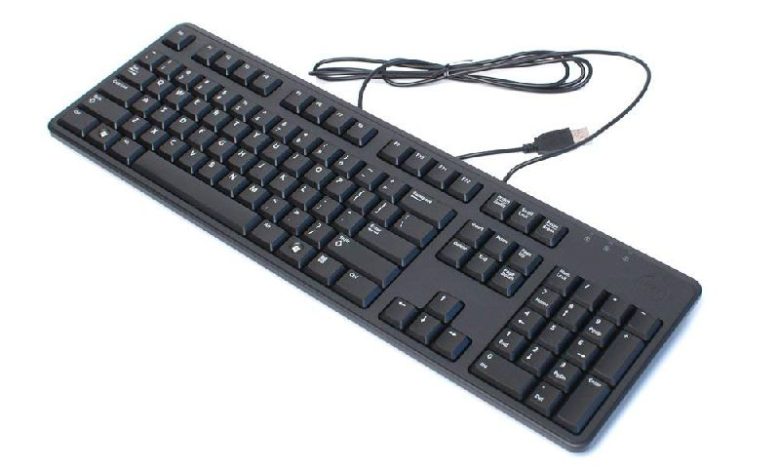Get to Know Your Dell Laptop Keyboard Inside Out

Introduction
The keyboard on your Dell laptop is an essential tool for productivity and communication. To make the most of your laptop experience, it’s crucial to understand your keyboard inside out. In this guide, we will delve deep into the intricacies of your Dell laptop keyboard, exploring its layout, special functions, customization options, and troubleshooting tips.
Whether you’re a seasoned user or new to Dell laptops, this comprehensive introduction will empower you to master your keyboard and enhance your computing experience. Let’s embark on a journey to unlock the full potential of your Dell laptop’s keyboard.
The Technology Behind Dell Keyboards
Dell keyboards are a crucial input device that facilitates interaction between users and their computers.
Membrane Key Switches:
Many Dell keyboards use a membrane key switch mechanism. This technology consists of multiple layers of flexible sheets with conductive traces, separated by rubber or silicone dome-shaped switches. When a key is pressed, the top layer makes contact with the bottom layer, registering a keypress. Membrane key switches are known for their durability and quiet operation.
Scissor Switches:
Some Dell laptops and keyboards feature scissor switch key mechanisms. Scissor switches provide a more tactile and responsive typing experience compared to membrane switches. They are characterized by their “scissor” mechanism that stabilizes each key, reducing wobbling and improving accuracy.
Chiclet Keyboards:
Chiclet-style keyboards have become popular in modern Dell laptops. They feature keys with a distinct square or rectangular shape, resembling pieces of Chiclet gum. Chiclet keyboards offer a comfortable and spacious typing surface, making it easier to type accurately.
Backlighting:
Many Dell laptops and keyboards come equipped with backlighting technology. Backlit keyboards have LED lights underneath each key, allowing users to type in low-light or dark environments. The backlighting can often be customized in terms of brightness and color, enhancing both functionality and aesthetics.
Multimedia and Function Keys:
Dell keyboards typically include dedicated multimedia and function keys. These keys offer quick access to functions like adjusting volume, brightness, and media playback controls. They enhance user convenience by reducing the need to navigate through software menus.
Customization Software:
Dell provides customization software that allows users to remap keys, create macros, and personalize their keyboard settings. This software enables users to tailor their keyboard’s functionality to their specific needs and preferences.
Wireless Connectivity:
Dell also offers wireless keyboards that connect to laptops and desktops via Bluetooth or USB dongles.
Durability and Build Quality:
Dell keyboards are designed to withstand the rigors of daily use. They are built with durable materials to ensure longevity and are often spill-resistant to protect against accidental liquid spills.
Ergonomic Design:
Dell pays attention to ergonomic design principles, ensuring that their keyboards are comfortable to use for extended periods. Features like adjustable tilt angles and palm rests are incorporated to reduce strain and improve user comfort.
Gaming Keyboards:
Dell’s gaming laptops and peripherals, such as Alienware keyboards, incorporate advanced gaming-specific technologies like customizable RGB lighting, mechanical key switches, anti-ghosting, and high polling rates to cater to the needs of gamers.
Tips for Maintenance and Care Of Dell Laptop Keyboard
Proper maintenance and care of your Dell laptop keyboard are essential to ensure its longevity and optimal performance.
Clean Regularly:
Dust and debris can accumulate between the keys and affect keypresses. Use compressed air to blow away loose particles, or gently clean the keys with a soft brush or lint-free cloth.
For stubborn dirt or smudges, you can use a mixture of isopropyl alcohol and water (1:1) on a soft cloth to wipe the keys. Make sure the laptop is powered off and disconnected from any power source before cleaning.
Avoid Eating and Drinking Near Your Laptop:
Food crumbs and liquid spills can be detrimental to your keyboard. Try to keep your laptop away from food and drinks to prevent accidental spills and crumbs from getting inside the keys.
Use a Keyboard Cover:
A keyboard cover can protect your laptop’s keyboard from spills, dust, and dirt. There are silicone and plastic covers available that can be easily placed over the keyboard and removed for cleaning.
Be Gentle When Typing:
Avoid excessive force when typing. Dell laptop keyboards are designed to register keypresses with minimal pressure. Excessive force can lead to keycap damage or loosening.
Keep Your Hands Clean:
Clean hands reduce the transfer of oils and dirt to the keyboard keys. Oils from your fingers can build up on the keys over time and affect their appearance and function.
Laptop Bag or Sleeve:
When transporting your laptop, use a padded laptop bag or sleeve to protect it from impacts that could damage the keyboard.
Adjust Keyboard Settings:
Customize your keyboard settings in the operating system to suit your typing preferences. You can adjust key repeat rates, keyboard language settings, and more through the Control Panel or Settings on Windows and System Preferences on macOS.
Update Drivers and Firmware:
Regularly update your laptop’s keyboard drivers and firmware to ensure compatibility and performance. Dell often releases driver and firmware updates through their support website.
Use an External Keyboard:
If you’re doing heavy typing tasks for an extended period, consider using an external keyboard.
Perform Periodic Maintenance:
Dell laptops may require periodic maintenance by a professional technician to clean and service the keyboard and internal components. This can help prevent issues caused by internal dust accumulation or worn-out components.
Back Up Your Data:
In case of keyboard malfunctions or other hardware issues, regularly back up your important data to prevent data loss.
Troubleshooting Dell Keyboard Issues
Encountering issues with your Dell laptop keyboard can be frustrating, but many common problems can be resolved with some troubleshooting steps.
1. Restart Your Laptop:
Sometimes, a simple restart can resolve keyboard issues caused by temporary software glitches.
2. Check for Physical Obstructions:
Inspect the keyboard for any physical obstructions, such as debris or foreign objects lodged between the keys. Gently remove any visible debris.
3. Clean the Keyboard:
Dust and dirt can accumulate under the keys over time. Use compressed air to blow out any loose particles or gently clean the keys with a soft brush or lint-free cloth.
4. Test in Safe Mode:
Boot your laptop into Safe Mode to check if the keyboard issue persists. If the keyboard works in Safe Mode, it may be due to a third-party software conflict.
5. Update Keyboard Drivers:
Outdated or corrupted keyboard drivers can cause problems. Visit Dell’s official website, enter your laptop’s model number, and download the latest keyboard drivers. Install them and restart your laptop.
6. Check for Driver Conflicts:
Occasionally, other software or drivers may conflict with your keyboard. Review recently installed or updated software and consider uninstalling or updating any that may be causing conflicts.
7. Use On-Screen Keyboard:
If some keys are not working, you can use the on-screen keyboard (OSK) as a temporary solution. Search for “On-Screen Keyboard” in your Windows search bar and use it to type until the issue is resolved.
8. Reconnect External Keyboards:
If you’re using an external keyboard, disconnect and reconnect it to ensure a secure connection. Sometimes, loose connections can cause keyboard problems.
9. Run Dell Diagnostics:
Dell laptops often come with built-in diagnostics tools. To run diagnostics, restart your laptop and press the F12 key repeatedly until the Boot Menu appears. Choose “Diagnostics” and follow the on-screen instructions to test your keyboard and other hardware components.
10. Check for Updates and Firmware:
Ensure that your laptop’s operating system is up to date, as well as any firmware updates available for your laptop model. These updates may include fixes for keyboard-related issues.
11. Test in Another User Profile:
Create a new user profile on your laptop and see if the keyboard works correctly in that profile. If it does, the problem may be specific to your user profile.
12. Check for Hardware Damage:
Physically inspect the keyboard for signs of damage, such as loose or missing keys. If there is visible damage, you may need to replace the keyboard.
13. Restore or Reset Your Operating System:
If none of the above steps resolve the issue and you suspect a software problem, consider performing a system restore (Windows) or reinstalling the operating system (after backing up your data) to rule out any software-related problems.
14. Contact Dell Support:
If the keyboard issue persists and you believe it’s a hardware problem or if your laptop is under warranty, contact Dell customer support or visit an authorized service center for professional assistance and potential keyboard replacement.
Conclusion
In conclusion, your Dell laptop keyboard is a vital component that requires proper care and attention to ensure it functions optimally. Regular maintenance practices such as cleaning, checking for physical obstructions, and keeping software and drivers up to date can go a long way in preventing common keyboard issues. Troubleshooting steps, including restarting your laptop, testing in Safe Mode, and checking for driver conflicts, can help diagnose and resolve keyboard problems that may arise.
If you encounter persistent issues that cannot be resolved through troubleshooting, it’s advisable to seek professional assistance from Dell’s customer support or an authorized service center, especially if your laptop is under warranty. Taking proactive steps to maintain and address keyboard issues will help you enjoy a comfortable and productive computing experience with your Dell laptop.



